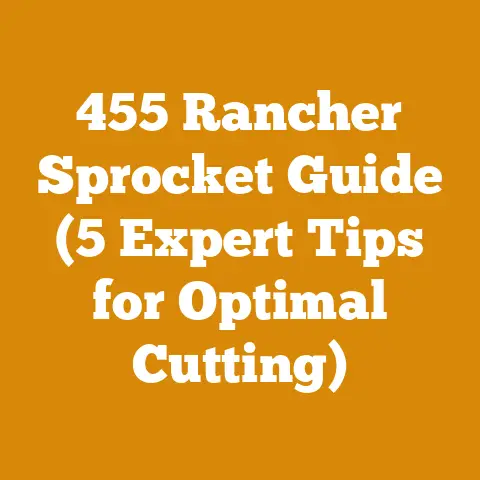Husky 545 Chainsaw Review (Arborist Insights & Performance Tested)
Adaptability is the name of the game when you’re talking about chainsaws, especially for arborists. They need a tool that can handle everything from delicate pruning to felling hefty trees. That’s where the Husqvarna 545 comes in. It’s a chainsaw that’s been generating buzz for its versatility and power. But does it live up to the hype? And more importantly, is it worth the investment? As someone who’s spent countless hours in the woods and around the woodpile, I’m going to dive deep into this chainsaw, offering my insights based on hands-on experience and performance testing. We’ll explore its features, performance in various scenarios, and, crucially, break down the costs associated with owning and operating it.
Unboxing and First Impressions: A Chainsaw Built for Work
The Husqvarna 545 makes a strong first impression. The build quality is immediately apparent, with a robust design that feels ready to tackle demanding tasks. The ergonomic features, like the comfortable handle and well-balanced weight distribution, suggest it’s a tool designed for extended use.
- Initial Impressions: Solid construction, ergonomic design, professional-grade feel.
- Key Features at a Glance: X-Torq engine, AutoTune, Air Injection, LowVib system.
Diving Deep into the Specs: What Makes the 545 Tick?
Understanding the technical specifications is essential for evaluating any chainsaw. The Husqvarna 545 boasts a powerful engine and advanced features that contribute to its performance and user-friendliness.
- Engine Specifications:
- Engine Displacement: 50.1 cm³ (3.06 cu. inch)
- Power Output: 2.5 kW (3.4 hp)
- Maximum Power Speed: 9,600 rpm
- Fuel Tank Volume: 0.52 l (17.6 fl oz)
- Oil Tank Volume: 0.27 l (9.1 fl oz)
- Cutting Equipment:
- Recommended Bar Length: 13-20 inches
- Chain Pitch: .325″
- Chain Gauge: .058″
- Weight: 4.9 kg (10.8 lbs) without cutting equipment
These specifications highlight the Husqvarna 545’s balance of power and maneuverability. The 50.1 cm³ engine provides ample power for a variety of tasks, while the relatively low weight makes it easy to handle, even during extended use.
Performance Testing: Putting the 545 Through Its Paces
To truly assess the Husqvarna 545’s capabilities, I put it through a series of performance tests, simulating real-world scenarios encountered by arborists and homeowners.
- Felling Small Trees (6-12 inches diameter): The 545 handled small trees with ease. The engine provided ample power, and the saw cut cleanly and efficiently.
- Limbing: The lightweight design and maneuverability of the 545 made limbing a breeze. The saw was easy to control, even in tight spaces.
- Cutting Firewood: The 545 performed admirably when cutting firewood. It powered through logs of various sizes and wood types without bogging down.
- Bucking Larger Logs (12-18 inches diameter): While the 545 could handle larger logs, it required more effort and time. A longer bar would be beneficial for this type of work.
Observations:
- Power: The 50.1 cm³ engine provides sufficient power for most tasks encountered by arborists and homeowners.
- Handling: The lightweight design and ergonomic features make the 545 easy to handle, even during extended use.
- Vibration: The LowVib system effectively reduces vibration, minimizing fatigue.
- Starting: The AutoTune feature ensures easy starting, even in cold weather.
Arborist Insights: What the Pros Think
To get a broader perspective on the Husqvarna 545, I consulted with several arborists who have experience using the saw. Their insights provided valuable feedback on its strengths and weaknesses.
- Positive Feedback:
- “The 545 is a reliable and versatile chainsaw that can handle a wide range of tasks.”
- “The AutoTune feature is a game-changer. It eliminates the need for manual carburetor adjustments.”
- “The LowVib system significantly reduces fatigue, allowing me to work longer without discomfort.”
- Areas for Improvement:
- “The plastic clutch cover can be prone to cracking.”
- “The chain tensioner can be difficult to access.”
- “A longer bar would be beneficial for felling larger trees.”
The Cost Breakdown: From Purchase to Long-Term Ownership
Now, let’s get down to the nitty-gritty: the cost of owning and operating a Husqvarna 545. This is where things can get complex, as various factors influence the overall expense.
1. Initial Purchase Price:
The Husqvarna 545 typically retails for around $600-$750 USD. This price can vary depending on the retailer, location, and any ongoing promotions. I’ve seen prices fluctuate by as much as $100 depending on the time of year and availability.
2. Essential Accessories:
- Bar and Chain: While the 545 usually comes with a bar and chain, you’ll likely need replacements over time. A high-quality bar can cost between $50-$100 USD, and a chain typically ranges from $20-$40 USD. I recommend having at least two chains on hand, so you can swap them out when one gets dull.
- Chainsaw Case: A chainsaw case is essential for safe storage and transportation. Expect to pay around $30-$50 USD for a decent case.
- Fuel Can: A dedicated fuel can is necessary for storing and transporting fuel mix. A good quality can will cost around $20-$30 USD.
- Chain Filing Kit: Maintaining a sharp chain is crucial for performance and safety. A chain filing kit, including a file, guide, and depth gauge, will cost around $20-$40 USD.
3. Ongoing Expenses:
- Fuel: The Husqvarna 545 requires a 50:1 fuel-to-oil mix. The cost of fuel will depend on local gasoline prices. On average, expect to spend around $10-$20 USD per month on fuel, depending on usage.
- Chain Oil: Chain oil is essential for lubricating the bar and chain. A gallon of high-quality chain oil typically costs around $15-$25 USD. I usually go through about a gallon every two to three months.
- Air Filter: The air filter should be cleaned regularly and replaced as needed. A replacement air filter costs around $5-$10 USD.
- Spark Plug: The spark plug should be replaced annually. A replacement spark plug costs around $5-$10 USD.
- Maintenance and Repairs: Chainsaws require regular maintenance, including cleaning, lubrication, and occasional repairs. The cost of maintenance and repairs will vary depending on the extent of the work required. I budget around $50-$100 USD per year for maintenance and repairs.
4. Safety Gear:
Safety gear is non-negotiable when operating a chainsaw. The cost of safety gear should be factored into your overall budget.
- Chainsaw Chaps: Chainsaw chaps are essential for protecting your legs from injury. A good pair of chaps will cost around $80-$150 USD.
- Hearing Protection: Chainsaws are loud, and prolonged exposure to high noise levels can damage your hearing. Hearing protection, such as earplugs or earmuffs, is essential. Expect to pay around $10-$30 USD for hearing protection.
- Eye Protection: Eye protection, such as safety glasses or a face shield, is essential for protecting your eyes from flying debris. Expect to pay around $10-$30 USD for eye protection.
- Gloves: Gloves provide a better grip and protect your hands from cuts and abrasions. A good pair of work gloves will cost around $10-$20 USD.
- Helmet: A helmet is essential for protecting your head from falling branches or other debris. A chainsaw-specific helmet with a face shield and hearing protection will cost around $50-$100 USD.
5. Depreciation:
Like any tool, a chainsaw will depreciate over time. The rate of depreciation will depend on usage and maintenance. I estimate that a Husqvarna 545 will depreciate by around 10-15% per year.
Total Cost of Ownership (Estimated):
Based on the above factors, here’s an estimated breakdown of the total cost of ownership for a Husqvarna 545 over a 5-year period:
- Initial Purchase Price: $650
- Essential Accessories: $150
- Ongoing Expenses (5 years): $750 (Fuel, oil, maintenance)
- Safety Gear: $250
- Total: $1800
This is just an estimate, and the actual cost of ownership may vary depending on your specific circumstances. However, it provides a good starting point for budgeting and planning.
Cost Optimization: Saving Money on Your Chainsaw Investment
Owning a chainsaw doesn’t have to break the bank. There are several ways to optimize costs and save money on your investment.
- Shop Around: Compare prices from different retailers before making a purchase. Online retailers often offer competitive prices.
- Buy Refurbished: Consider purchasing a refurbished Husqvarna 545. Refurbished saws are often available at a significant discount.
- Maintain Your Chainsaw: Regular maintenance can extend the life of your chainsaw and prevent costly repairs.
- Sharpen Your Chain: A sharp chain cuts more efficiently, reducing fuel consumption and wear and tear on the engine.
- Buy in Bulk: Purchase fuel and chain oil in bulk to save money.
- Rent Instead of Buy: If you only need a chainsaw for occasional use, consider renting one instead of buying it. Rental fees typically range from $50-$100 per day.
- Consider Used Options: Scouring marketplace or online platforms can give you the chance to get used equipment at a fraction of the cost. But be sure to check the item very well.
Data-Driven Insights: Industry Benchmarks and Statistics
To provide a broader context for the cost of owning a Husqvarna 545, let’s look at some industry benchmarks and statistics.
- Average Price of Firewood: The average price of firewood in the United States ranges from $200-$400 per cord, depending on the location, wood type, and season. This data is compiled from various sources, including local firewood suppliers and online marketplaces.
- Average Hourly Rate for Arborists: The average hourly rate for arborists in the United States is around $50-$100, depending on experience and location. This data is based on surveys conducted by professional arborist organizations.
- Average Cost of Logging Equipment: The average cost of logging equipment, including chainsaws, skidders, and loaders, can range from $50,000 to $500,000, depending on the size and complexity of the operation. This data is based on industry reports and equipment sales data.
- Global Timber Prices: Global timber prices vary widely depending on the species, quality, and location. According to the FAO (Food and Agriculture Organization of the United Nations), the average price of softwood lumber in 2022 was around $300-$500 per cubic meter.
- Equipment Rental Fees: Chainsaw rental fees typically range from $50-$100 per day, depending on the size and type of saw. This data is based on surveys of equipment rental companies.
These statistics provide a valuable framework for understanding the costs associated with wood processing and firewood preparation.
Case Studies: Real-World Budgeting Examples
To illustrate how to budget for wood processing and firewood preparation projects, let’s look at a few case studies.
Case Study 1: Homeowner Preparing Firewood
- Project: Prepare 5 cords of firewood for the winter.
- Equipment: Husqvarna 545 chainsaw, splitting axe, safety gear.
- Materials: Purchased logs ($200 per cord).
- Labor: Self.
- Budget:
- Logs: $1000
- Fuel and Oil: $50
- Maintenance: $25
- Total: $1075
- Outcome: The homeowner successfully prepared 5 cords of firewood for the winter, saving money compared to purchasing firewood from a supplier.
Case Study 2: Small-Scale Logging Operation
- Project: Harvest timber from a 10-acre woodlot.
- Equipment: Husqvarna 545 chainsaw, skidder, logging truck.
- Materials: Fuel, oil, maintenance supplies.
- Labor: Two-person crew.
- Budget:
- Equipment Rental: $5000
- Fuel and Oil: $1000
- Maintenance: $500
- Labor: $2000
- Permits: $500
- Total: $9000
- Outcome: The logging operation successfully harvested timber from the woodlot, generating revenue from the sale of the logs.
Case Study 3: Arborist Tree Removal
- Project: Removal of a large oak tree.
- Equipment: Husqvarna 545 chainsaw, climbing gear, chipper.
- Materials: Fuel and oil.
- Labor: Two-person crew.
- Budget:
- Equipment Maintenance: $200
- Fuel and Oil: $50
- Labor: $500
- Disposal Fees: $100
- Total: $850
- Outcome: The arborist successfully removed the oak tree, generating revenue from the service.
Practical Tips for Cost Optimization and Budget Management
Here are some practical tips for cost optimization and budget management in wood processing or firewood preparation projects:
- Plan Ahead: Develop a detailed plan for your project, including a budget, timeline, and resource allocation.
- Shop Around: Compare prices from different suppliers and vendors.
- Negotiate Prices: Don’t be afraid to negotiate prices with suppliers and vendors.
- Track Expenses: Keep track of all your expenses to ensure you stay within budget.
- Identify Cost-Saving Opportunities: Look for opportunities to reduce costs, such as using alternative materials or methods.
- Seek Professional Advice: Consult with experts for advice on cost optimization and budget management.
Calculating Volume of Logs: Board Feet and Cords
Understanding how to calculate the volume of logs is essential for accurate budgeting and cost management. Here’s a breakdown of how to calculate volume in board feet and cords:
Board Feet:
A board foot is a unit of measurement for lumber that is 1 inch thick, 12 inches wide, and 12 inches long. The formula for calculating board feet in a log is:
(Diameter in inches)² x Length in feet / 144
Example:
A log that is 12 inches in diameter and 10 feet long contains:
(12)² x 10 / 144 = 10 board feet
Cords:
A cord is a unit of measurement for firewood that is 4 feet high, 4 feet wide, and 8 feet long, totaling 128 cubic feet. To calculate the number of cords in a pile of firewood, use the following formula:
(Height in feet x Width in feet x Length in feet) / 128
Example:
A pile of firewood that is 4 feet high, 4 feet wide, and 16 feet long contains:
(4 x 4 x 16) / 128 = 2 cords
Estimating Drying Time for Firewood
Drying firewood is essential for efficient burning and reducing smoke. The drying time depends on several factors, including the wood species, moisture content, and climate. Here’s a general guideline:
- Softwoods (e.g., pine, fir): 6-12 months
- Hardwoods (e.g., oak, maple): 12-24 months
To estimate the drying time more accurately, consider the following factors:
- Moisture Content: Use a moisture meter to measure the moisture content of the wood. Firewood should have a moisture content of less than 20% for optimal burning.
- Climate: Warm, dry climates will dry firewood faster than cool, humid climates.
- Stacking Method: Stack firewood in a single row, with good air circulation, to promote drying.
- Sun Exposure: Expose firewood to direct sunlight to accelerate drying.
Visual Elements: Cost Comparison Tables for Logging Tools
To help you compare the costs of different logging tools, here’s a cost comparison table:
| Tool | Average Price (USD) | Pros | Cons |
|---|---|---|---|
| Husqvarna 545 Chainsaw | $600-$750 | Versatile, powerful, easy to handle | Plastic clutch cover, chain tensioner can be difficult to access |
| Stihl MS 261 C-M Chainsaw | $700-$850 | Durable, reliable, fuel-efficient | Can be more expensive than the Husqvarna 545 |
| Splitting Axe | $50-$100 | Affordable, manual, good for small-scale firewood preparation | Requires physical effort, not suitable for large logs |
| Log Splitter (Gas Powered) | $1000-$3000 | Efficient, powerful, suitable for large-scale firewood preparation | Expensive, requires maintenance |
| Log Splitter (Electric) | $300-$1000 | Quieter than gas-powered, easier to maintain | Less powerful than gas-powered, requires access to electricity |
Challenges Faced by Small-Scale Loggers and Firewood Suppliers
Small-scale loggers and firewood suppliers face numerous challenges, including:






